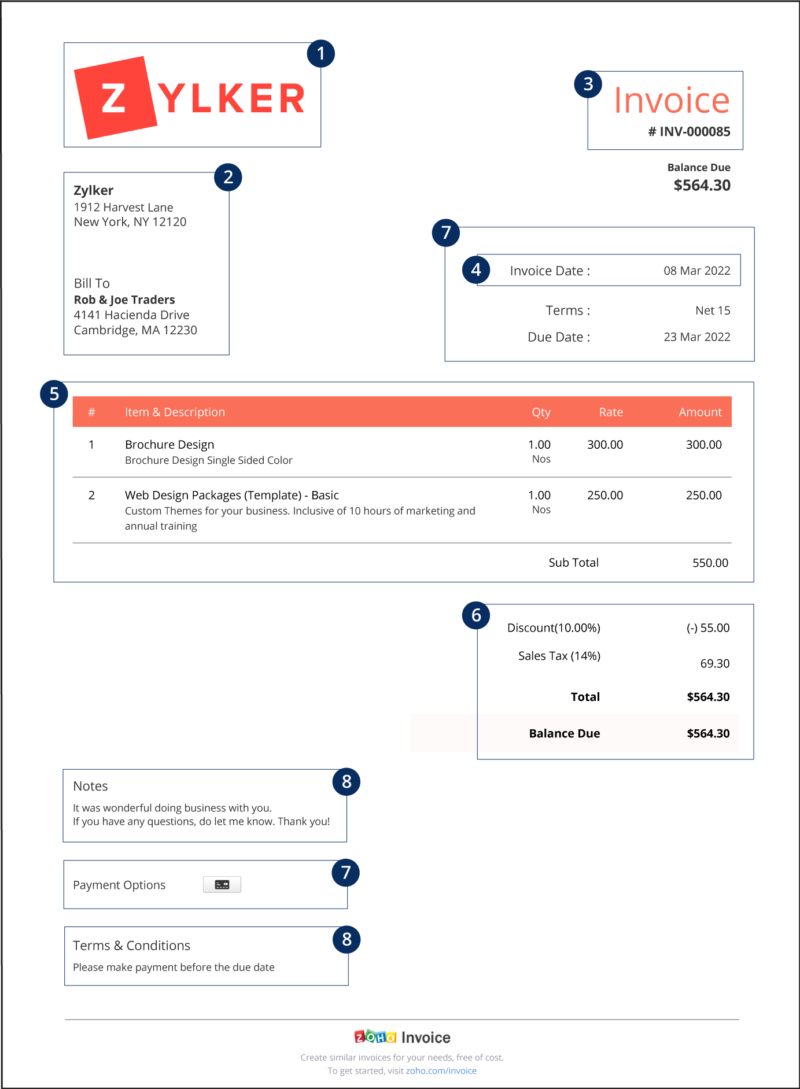- HOME
- Billing basics
- How to create an invoice: A step-by-step guide
How to create an invoice: A step-by-step guide
According to a report from Credit Research Foundation, on average, 61% of late payments are due to administrative problems such as incorrect invoices. A clear and accurate invoice goes a long way in sustaining your business as a successful entity. It reflects your professionalism and works as brand equity, helping you retain more customers. On the other hand, inaccurate invoices tend to confuse your customers, lowering their interest in doing business with you, and cause payment delays—ultimately affecting your cash flow. It's important to understand how invoices work the importance of invoices and ensure every element is captured accurately.
There are several ways to create an invoice. Many businesses use a document creation app like Microsoft Word or a spreadsheet to make invoices from scratch or from a limited set of pre-installed templates. Other businesses use invoice templates available online. However, these manual invoice creation methods may become challenging as the business grows, and dedicated invoicing software can help to streamline the entire process.
Online invoicing software helps you create professional invoices both in the office and on the go, and can significantly reduce the threat of human errors. With efficient online invoicing software, it takes a few clicks to send invoices online in a matter of seconds and collect payments automatically. It enables your clients to select their preferred currency and language, making your business entering the global marketplace much more convenient. On the whole, from ensuring accurate billings to providing positive brand reinforcement, online invoicing software has a lot to offer.
Here's an example of a professional invoice created using online invoicing software. We have highlighted the critical elements you should include in an invoice and explained why you should include them.

Brand your invoice
Customizing your invoices helps boost your brand awareness. The colors, fonts, logo, and other branding components make the invoices look more professional and reflect the values that your business wants to represent to your customers. Ensure that the invoice design matches the elements and colors of your website, social channels, and other content pages, as it is crucial to maintain consistency and be easily recognizable across the board.
Add a professional header
Start the invoice with a professional header that includes the business name, business logo (if any), address, and contact information. After this, add the client's business name, the name of the contact person, and their precise contact information. If your business collects sales tax, then include the business's tax ID as mandated by regional laws. For example, Indian businesses include GST numbers while ABN numbers are used by Australian businesses and VAT IDs in multiple countries including the European Union.
If the business sending the invoice is a limited company, it's best to add the company's registration number.
Include invoice information
Label the document with the word "Invoice" for the customer to identify it easily. Include a unique invoice ID number to track your transactions. The invoice ID is usually alphanumeric and includes specific information such as project name or date of invoice issue. Each business should choose an invoice numbering system that works for them and stick to it to avoid confusion.
Include the dates
Include the date the goods/services are delivered (the supply date) and the date the invoice is issued, to establish a timeline and track payments.
Description of goods/services delivered
The invoice should list all goods sold or services rendered by the business in exchange for a fee during that specific invoice period. Include each item sold, its quantity, rate per unit, and subtotal. For services, include the time spent for each line item and provide details for that specific service.
This practice can help make your work and pricing more transparent and encourage faster payment.
For instance, if you are invoicing for a fence you built, list the cost of all the fencing boards and nails along with the time spent on the project. These details should be presented individually so that both you and your customers get clarity on the project cost.
Include tax details and highlight the total money owed
Payment terms specify when and how the business expects customers to pay them. This should include:
The invoice issue date
The expected date of payment
Payment methods accepted by the business (credit card, check, PayPal, etc.)
Late payment penalties
Currencies that the business accepts
Any other payment conditions, including early payment discounts
Include payment terms
Include the tax details that apply to the sale, which vary depending on the country's regulations, local tax rate, type of business, and other factors. Typically, when an invoice has multiple line items, the total tax liability is calculated for the final invoice amount and displayed at the bottom. You can split the tax amount according to the different tax groups the billable items fall under, instead of calculating the tax on each item.
Once the tax and discounts (if any) are accounted into the calculation, tally up the sum and highlight the total amount owed by the customer.
Add explanatory notes with terms and conditions
Although invoices are self-explanatory, there are chances for confusion. For instance, customers might miss that you have applied a discounted price for one of your products. To prevent this, you can add an explanatory footnote about the discount so that customer understands that future invoices may show higher rates for the same product. Also, ensure you add any other applicable charges on your invoices, especially payment processing fees, and overdue penalty charges.
You can also outline the conditions under which customers can return or exchange items they have purchased. For instance, you might state that your business will accept returns/replacements with a valid receipt for 30 days after purchase if the products returned do not have any signs of usage with packaging intact.
Key takeaway
It is important to be aware of the elements to be included in your invoice, and also to present them effectively so that your customer understands the invoice and makes the payment promptly. Fortunately, creating the perfect invoice is easy with efficient online invoicing software like Zoho Invoice.
Unlike creating an invoice manually, Zoho Invoice lets you simply pick a pre-built invoice layout and add your business logo and company details automatically. If you have already added the customer details in your organization, you can simply choose the customer information and fill in their purchase details from the drop-down menu. This saves you loads of time that would have otherwise been spent creating individual invoices and filling in the details manually every time you make a sale.
With Zoho Invoice, you get to choose from a wide range of customizable invoice templates, automate your payment reminders, and collect payments online seamlessly. While you are busy perfecting your products and services to fulfill your customers' expectations, Zoho Invoice will take care of your invoicing process and help you get paid on time.
